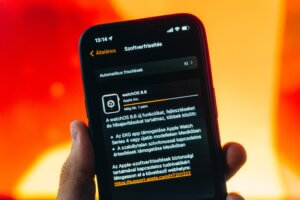After reading this article, you’ll:
- Understand the unique benefits and challenges of choosing native app development for healthcare applications, including its impact on features, user experience, and data security.
- Gain insights into the various aspects that healthcare stakeholders should consider when opting for native apps, such as compliance with data protection laws, integration with existing systems, and long-term scalability.
- Learn how to navigate the trade-offs between native and non-native app development to make an informed decision that aligns with the specific needs of the healthcare organization, ultimately contributing to improved patient outcomes and a more secure healthcare environment.

In an age where smartphones serve as an extension of ourselves, the healthcare industry is increasingly leveraging mobile applications to enhance patient care, streamline administrative processes, and even manage chronic conditions. While the discussion around the development of healthcare apps often revolves around features, user experience, and HIPAA compliance, the choice between native and non-native app development frameworks remains crucial yet somewhat overlooked. This decision not only impacts the functionality and usability of the app but also plays a significant role in data security—a paramount concern in healthcare.
In this article, we delve deep into both the benefits and drawbacks of opting for native app development for healthcare applications. We aim to provide a balanced perspective to help stakeholders, ranging from hospital administrators to software developers, make informed decisions in their pursuit of creating impactful, secure, and user-friendly healthcare apps.
What is a Native App?
 A native app is a software application developed specifically for a particular operating system or platform, such as Android or iOS. Unlike web apps, which are accessed through a web browser, or hybrid apps, which are a combination of both, native apps are designed to be “native” to a particular ecosystem. This means they are developed using programming languages that are specific to the platform they are built for—Objective-C or Swift for iOS, and Java or Kotlin for Android, for example.
A native app is a software application developed specifically for a particular operating system or platform, such as Android or iOS. Unlike web apps, which are accessed through a web browser, or hybrid apps, which are a combination of both, native apps are designed to be “native” to a particular ecosystem. This means they are developed using programming languages that are specific to the platform they are built for—Objective-C or Swift for iOS, and Java or Kotlin for Android, for example.
Understanding what a native app is and how it differs from other types of apps is critical for healthcare organizations. The unique benefits and challenges it presents can have a significant impact on the efficiency and quality of healthcare services, patient engagement, data security, and regulatory compliance. A thorough evaluation is essential before opting for native app development in a healthcare context.
Benefits of Native App Development For Healthcare Apps
Better Features
Native healthcare apps are particularly well-suited for integrating real-time monitoring features, such as keeping track of a patient’s vitals or chronic conditions remotely. This is crucial for healthcare providers who require immediate access to up-to-date medical information for timely diagnosis and treatment plans. Native apps can better leverage device capabilities, ensuring that monitoring is seamless and accurate.
Native apps have an edge in telehealth services because they can offer more robust features like high-quality video conferencing and real-time consultation functionalities. This enhanced capability is invaluable for healthcare providers who want to reach patients in remote areas or offer convenient consultation options, thereby expanding their services and improving patient satisfaction.
High Performance
 One of the most compelling advantages of native apps is their optimized performance, including quicker load times. In the healthcare sector, time can be of the essence, especially in emergency situations. Native apps allow for the rapid retrieval and display of medical data, facilitating quicker decision-making processes for medical professionals.
One of the most compelling advantages of native apps is their optimized performance, including quicker load times. In the healthcare sector, time can be of the essence, especially in emergency situations. Native apps allow for the rapid retrieval and display of medical data, facilitating quicker decision-making processes for medical professionals.
Native apps offer the benefits of smooth animations and transitions, which is particularly useful for data visualization and complex medical imaging. Medical professionals often need to interpret intricate images like X-rays, MRIs, or CT scans. Smooth graphical rendering ensures that these images can be zoomed, rotated, and manipulated without lag, thereby aiding accurate diagnosis.
Superior Security
Security is a primary concern in healthcare due to the sensitive nature of medical data. Native apps generally offer robust encryption methods that can safeguard this data from unauthorized access. A well-designed native app can act as a fortress for patient and medical data, making it far less susceptible to breaches.
Beyond encryption, native apps can implement multi-level authentication processes. This means that a user might be required to go through facial recognition, fingerprint scanning, and/or enter a secure code to access the application. This multi-faceted approach to security further protects against unauthorized access to sensitive healthcare information.
Seamless User Experience (UX)
The user interface in native apps is often more intuitive because it is designed in accordance with the user experience guidelines of the specific operating system. In healthcare, an intuitive interface can make it easier for medical professionals and patients to navigate through large amounts of data, schedule appointments, and find relevant medical records.
Native apps offer an enhanced capability for customization according to individual user preferences. For instance, healthcare providers and patients can customize notification settings for medication reminders, upcoming appointments, or test result availability. This level of customization improves the app’s usefulness and adaptability in a medical context.
Enhanced Offline Capabilities
Having offline access to essential patient data can be invaluable in healthcare settings. Native apps can offer more reliable offline functionalities due to their better integration with device hardware. This can prove to be a lifesaver, especially in emergency situations where internet connectivity is unavailable.
While cloud storage is prevalent, there are situations in healthcare where local data storage is advantageous. Native apps can offer secure, fast, and reliable local data storage options, facilitating quicker access to critical patient information when needed.
Compliance and Regulation Adherence
Healthcare is a highly regulated industry with stringent data protection laws like HIPAA in the U.S. or GDPR in Europe. Native apps can be more easily tailored to adhere to these laws and guidelines. This customization reduces the legal risks associated with healthcare data management.
Native apps can more readily offer advanced features such as audit trails, which record every action taken within the application. This is crucial for healthcare providers to maintain a transparent record for compliance with legal requirements and quality checks.
Interoperability with Existing Systems
Native apps have an advantage when it comes to integrating with existing Electronic Health Records (EHR) systems. This can offer a streamlined way to pull and update patient data, making native apps an attractive option for healthcare providers already invested in EHR platforms.
Due to their high performance and better features, native apps are more efficient in data synchronization across different systems or departments. This is crucial in healthcare settings where consistent, real-time data is necessary for patient care.
Scalability and Future Expansion
Native apps are generally easier to scale, allowing healthcare organizations to add features or expand services as they grow. This scalability is crucial for long-term digital strategies, particularly for larger healthcare providers.
Investing in a native app can offer more flexibility for adopting future technological advancements. Whether it’s implementing AI-powered diagnostics or integrating AR-based medical training modules, native apps are generally better equipped to adapt to new technologies.
Potential Drawbacks of Native App Development For Healthcare Apps
Longer Development Process
Developing native apps means creating separate versions for iOS and Android, leading to a longer development cycle. This can be particularly challenging in healthcare where quick deployment of solutions may be required, such as in outbreak situations or medical emergencies. The longer development process is also resource-intensive, requiring skilled developers proficient in different programming languages for each platform, which can be a major hurdle for healthcare institutions with limited internal technical capabilities.
High Cost
The specialized skills and extended timeline required for native app development translate into higher initial expenses. This can be a significant burden for healthcare organizations, many of which operate on tight budgets or rely on public funding. Beyond development, native apps often require expensive software and licensing fees, adding to the overall budget. This can be a significant factor when healthcare organizations are trying to manage costs effectively.
Complex Updates And Maintenance
Updates to native apps must be developed and rolled out for each platform separately, complicating version management. For healthcare providers, ensuring that all users are on the most current version is crucial for delivering consistent care and maintaining security. Once a native app is deployed, it generally requires a higher level of ongoing maintenance, including regular updates for new operating system versions and security patches, which adds to the overall cost and complexity.
Platform Dependency
Native apps are restricted to specific platforms, limiting the app’s user base. In healthcare, this can be a major drawback, particularly for organizations aiming to be accessible to as many patients and providers as possible, regardless of their device. Being tied to specific platforms also means that native apps might not be optimized for all types of devices, such as older smartphones or tablets. This can be problematic in healthcare settings where a variety of hardware might be in use.
Technical Barriers for End-Users
Due to their complex features, native healthcare apps can be difficult for less tech-savvy patients or older adults to navigate, which can hinder the app’s effectiveness and adoption rate. Native apps require downloading and installation, a step that web apps don’t necessitate. This can be a barrier for users who are reluctant to download new software due to concerns about device storage or security.
Regulatory and Compliance Risks
Native apps, due to their advanced features and data storage capabilities, can fall under increased regulatory scrutiny. This necessitates a more rigorous compliance process, which can be challenging for healthcare organizations to navigate.
For healthcare organizations operating in multiple jurisdictions, native apps can pose challenges related to data localization laws, as data may be stored in specific locations depending on user settings or app architecture.
By taking into account these challenges along with the benefits, healthcare organizations can make a more informed decision when considering native app development. Planning for these potential pitfalls can help ensure a more successful and effective healthcare app deployment.
As the healthcare landscape continues to evolve, the decision to go native should be guided by a comprehensive understanding of both its merits and limitations. A tailored approach that considers the specific needs of the healthcare institution, the targeted user base, and the criticality of data security will often yield the most beneficial results. Stakeholders must carefully weigh the trade-offs and align them with their long-term objectives and capacities.
In the end, the goal is clear: to deliver a healthcare app that is not only functional and secure but also user-centric. By navigating the complexities of native versus non-native development paths, healthcare providers and developers have the opportunity to elevate the standard of care, improve patient outcomes, and ultimately, contribute to a healthier, more connected world.





